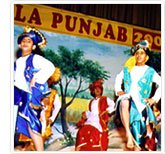Punjabi New Year / Sikh (Nanakshahi)
Baisakhi Festival, also called Vaisakhi, holds great importance for the Sikh community and farmers of Punjab. Baisakhi falls on April 13 or 14, the first day of the year according to the Nanakshahi Calender. Sikhs also celebrate this day in honor of their tenth guru, Guru Gobind Singh. Baisakhi commemorates the day when the Sikh Guru eliminated caste differences and founded Khalsa Panth in1689.
For the large farming community of Punjab and Haryana, Baisakhi marks the harvest time. Farmers celebrate it with immense fervor as they are loaded with cash at this time. Men and women run over the fields shouting “Jatta aayi Baisakhi”.

Baisakhi Traditions and Rituals
It is in the blood of every Sikh to follow the tradition of Baisakhi earnestly. They get up early in the morning, visit gurudwaras and offer prayers. Some people prefer to visit Golden Temple or Anandpur Sahib where Khalsa Panth was recognised.
In most of the gurudwaras, the holy books of Sikhs is cleansed with milk and water. The granthi of the gurudwara reads the Sikh holy scripture and the gathering of devotees listen to it seriously. Following the tradition from the time of Guru Gobind Singh Ji, an amrit is prepared in an iron vessel. The gathering of devotees sip this amrit five times. Later on, ragis sing devotional songs and perform a kirtan which is leaded by an ardas in afternoon. After performing all the religious traditions, the Karah Prasad is distributed amongst the congregation. The religious ceremony accomplishes with a Guru – ka – Langar. This is meal consists of Dal Makhani, any vegetarian dish, curd, salad and a sweet dish like semonila.
Baisakhi Celebrations
Traditional songs and dances boosts the spirit of the Baisakhi festival. After performing rituals in gurudwaras, people of Sikh community take out processions. The holy book of Sikhs is taken out in the processions. It is read in the holy book that the Sikh Guru asked five volunteers to sacrifice their lives, then he took each one of them into a tent and every time came out with a bloody sword but he actually sacrificed a goat. Thus, the procession is headed by five men to honor the Panj Pyaras.
Fervor and vigor of the festival can be seen in these hours long processions passing through various localities of the city. Sikh men and women wearing gaudy clothes perform the famous bhangra and gidda dance. Mock duels are also performed during Baisakhi processions. People carry forward the procession by chanting various hymes like ‘Jo Bole So Nihal’, ‘Deg Teg Fateh’ and ‘Satnam Shri Wahe Guru’. Vaisakhi celebrations are escalated by dramatizing sword fight, beating drums and bursting crackers. In some places, early morning Prabhat Pheris also take place.
At the end of the day, people express feelings of brotherhood, love, unity and also hope to celebrate the festival with same energy and enthusiasm every year.
NEW YEAR IN DIFFERENT PARTS OF INDIA
Menu



